
The American economy is slowly recovering from the COVID-19 pandemic. The unemployment rate has been decreasing, dropping to 5.8% in May from 6.1% in April. During the pandemic, despite severe job losses, average wages actually rose, as many lower-wage workers lost their jobs, while higher-income workers mostly kept theirs.
Though wages grew nationwide, many parts of the country are still lagging behind the national median. The U.S. median annual wage was $41,950 in 2020. Yet in many major metro areas, the median wage was thousands of dollars lower.
To determine the cities with the lowest paying jobs, 24/7 Wall St. reviewed data on median wage for 389 metropolitan statistical areas from the U.S. Bureau of Labor Statistics Occupational Employment and Wage Statistics program.
Of the 25 cities with the lowest paying jobs, 23 are in Southern states. Texas and Alabama are both home to four metro areas on this list, more than any other state. Florida and Arkansas both have three. Arizona and New Mexico are the only states outside of the South with a metro area on the list. These are America’s richest and poorest states.
Click here to see 25 cities with the lowest paying jobs.
Click here to see our detailed methodology.

25. Albany, GA
> Median annual wage: $32,810
> April 2021 unemployment rate: 5.7%
> Poverty rate: 22.6%
Albany, Georgia’s median annual wage of $32,810 is one of the lowest out of the nearly 400 American metro areas reviewed. The U.S. median annual wage is over $9,000 higher, at $41,950. From 2015 to 2020, the U.S. median wage increased by 15.9%, but wages increased by only 11.1% in Albany in that time, one of the lowest wage increases among U.S. metro areas.
Economic hardship is much more common in Albany than it is nationwide. The area has the 10th highest poverty rate of U.S. metro areas, at 22.6%. The U.S. poverty rate is 12.3%. Also, 12.1% of Albany households live on less than $10,000 per year — the second highest share in the country and more than double the 5.8% share nationwide.
[in-text-ad]

24. Auburn-Opelika, AL
> Median annual wage: $32,780
> April 2021 unemployment rate: 2.8%
> Poverty rate: 15.8%
Unlike all the other metro areas with the lowest paying jobs, the Auburn-Opelika metro area has a relatively high bachelor’s degree attainment rate. An estimated 41.4% of residents 25 and older hold at least a bachelor’s degree, compared to 33.1% of adults nationwide. The area is home to Auburn University, and income figures in college towns are often skewed. Many college students work part-time jobs or do not not work at all and are financially supported by their parents or guardians.
Of all the metro areas with the lowest median annual wages, Auburn had the lowest unemployment rate as of April 2021, at 2.8% — less than half of the national unemployment rate of 6.1%. The metro area’s largest sector by employment is food preparation and serving, with nearly one out of every eight workers in the area employed in the sector. Most of these workers earn less than $20,000 per year.
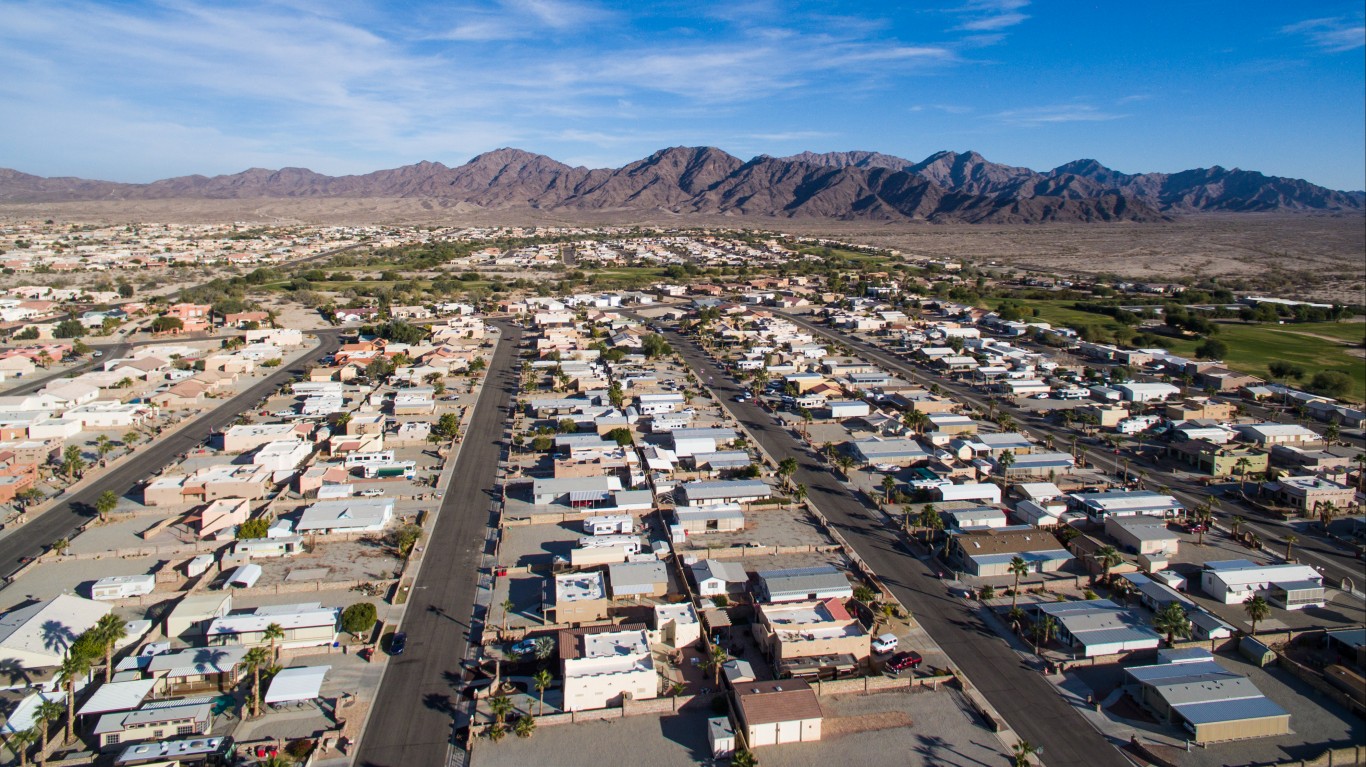
23. Yuma, AZ
> Median annual wage: $32,390
> April 2021 unemployment rate: 14.3%
> Poverty rate: 21.4%
Most Yuma, Arizona, workers earned less than $32,400 in wages in 2020, one of the lowest medians in America. However, this actually represents a major improvement as the area’s wages increased by 21.5% from 2015 to 2020, one of the largest increases among all U.S. metro areas. The Yuma metro area had one of the 10 lowest median annual wages five years earlier.
More than 10% of all workers in the Yuma area are farmworkers and laborers, making it by far the most highly concentrated occupation. These workers have median earnings of $27,600. While those working in the Yuma area earn relatively low wages, many are struggling to find work at all. Yuma’s April unemployment rate of 14.3% is the second-highest of nearly 400 U.S. metro areas and more than double the comparable 6.1% national rate.
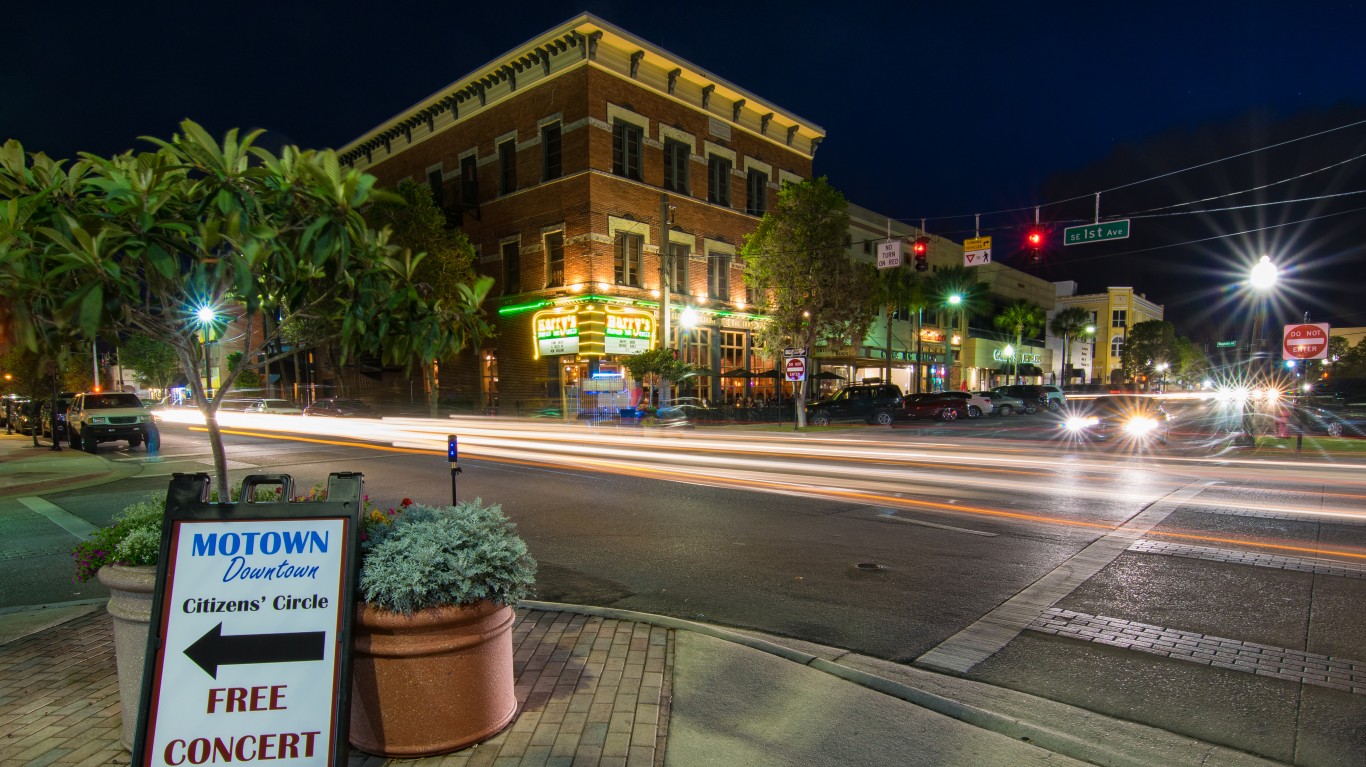
22. Ocala, FL
> Median annual wage: $32,350
> April 2021 unemployment rate: 6.5%
> Poverty rate: 15.0%
The Ocala metro area in central Florida has one of the lowest median annual wages of any major metro area in the nation — one of three Florida metro areas to have one of the 25 lowest median annual wages. The typical worker earns $32,350 per year, well below the U.S. median annual wage of nearly $42,000. .
The Ocala job market has expanded rapidly in recent years, growing from 95,500 total workers in 2015 to nearly 103,000 in 2020, a 7.8% increase. This is several times higher than the nationwide 0.9% total employment increase during that period. However, wage growth in Ocala lagged behind much of the country as the median annual wage grew by 11.4% from 2015 to 2020, compared to a 15.9% increase nationwide.
[in-text-ad-2]
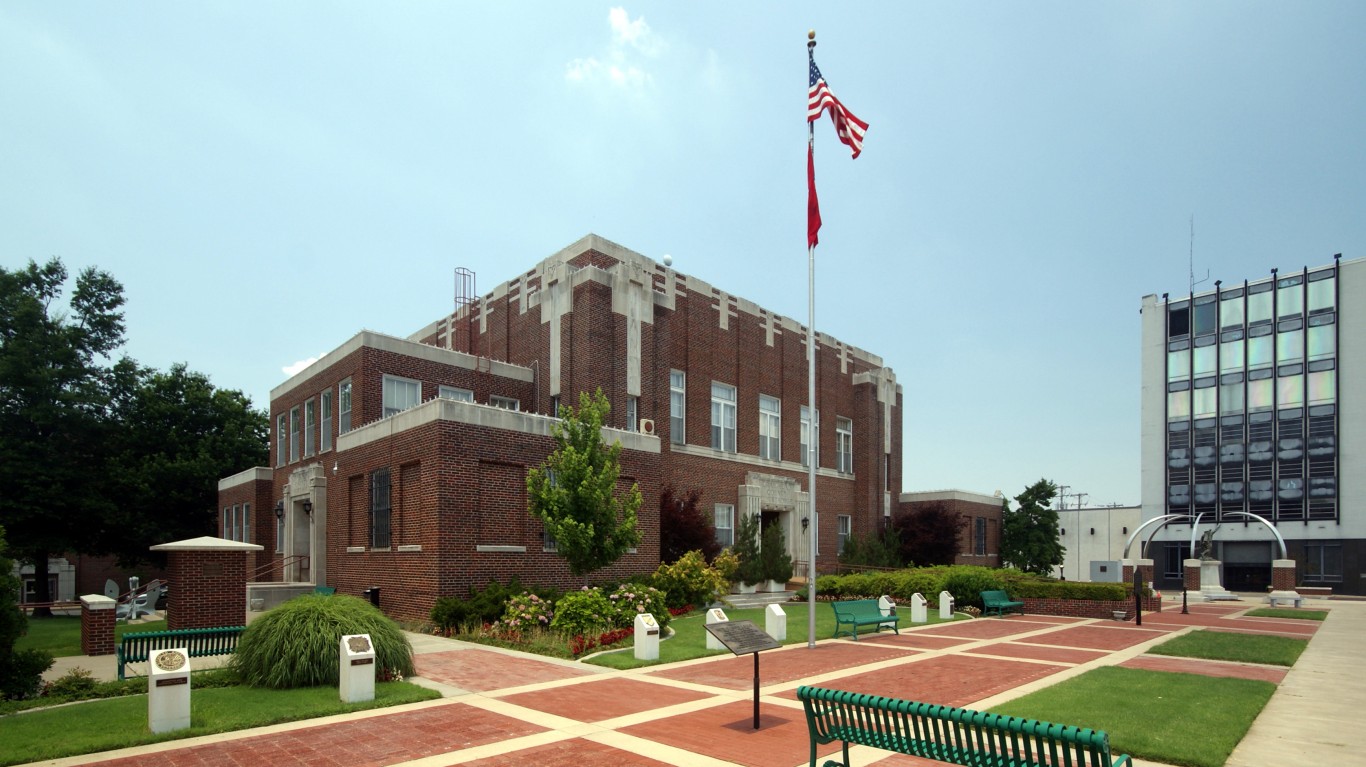
21. Jonesboro, AR
> Median annual wage: $32,180
> April 2021 unemployment rate: 3.8%
> Poverty rate: 18.9%
The median annual wage in Jonesboro, Arkansas, is $32,180 — a lower median than all but 20 other metro areas in the country. Likely at least partially as a result, the area has a relatively high poverty rate, at 18.9%. The U.S. poverty rate is 12.3%.
Though wages are relatively low in the metro area, there are some positive indicators for Jonesboro’s job market. The area’s unemployment rate of just 3.8% is well below the national unemployment rate of 6.1%. The number of workers expanded significantly in recent years, with total employment increasing by 6.6% from 2015 to 2020 — several times higher than the 0.9% increase in the total employment nationwide.

20. Las Cruces, NM
> Median annual wage: $32,100
> April 2021 unemployment rate: 7.7%
> Poverty rate: 25.9%
Along with Yuma, Arizona, the Las Cruces metro area of southern New Mexico is one of just two metro areas outside of the South to rank among the metro areas with the 25 lowest median annual wages. The median worker in Las Cruces earned just $32,100 in 2020.
The job market in the Las Cruces area is struggling — the number of workers decreased by 1.6% from 2015 to 2020. In April 2021, the area reported a 7.7% unemployment rate, well above the 6.1% national rate. The Las Cruces’ poverty rate is 25.9% — the third highest poverty rate in the country and more than double the 12.3% national poverty rate.
[in-text-ad]

19. Fort Smith, AR-OK
> Median annual wage: $31,930
> April 2021 unemployment rate: 5.0%
> Poverty rate: 19.4%
The Fort Smith area on the Arkansas-Oklahoma border is one of just 19 U.S. metro areas in which most workers earned less than $32,000 a year. The number of workers in the area declined by 5.8%, or over 6,000 workers, from 2015 to 2020, one of the steepest employment declines in the country.
Though wages in the Fort Smith area are relatively low, money tends to go farther in the metro area than in almost every other major population center in the country. The cost of living is more than 17% lower than the overall U.S. cost of living.

18. Morristown, TN
> Median annual wage: $31,890
> April 2021 unemployment rate: 4.8%
> Poverty rate: 11.9%
The median annual wage in the Morristown metro area in northeastern Tennessee is $31,890, among the lowest in the country. From 2015 to 2020, the median wage increased by just 10.6%. Out of nearly 400 U.S. metro areas, less than 20 had slower wage growth. More than one out of five area workers are employed in production occupations, like manufacturing. The median annual wage of these workers is $32,320, well below the median for all occupations nationwide of $41,950.
Though wages are relatively low in the Morristown metro area, poverty is relatively uncommon. The area’s poverty rate of 11.9% is slightly lower than the 12.3% national poverty rate. Also, just 4.5% of area households earn less than $10,000 per year, compared to 5.8% of all U.S. households.

17. Jacksonville, NC
> Median annual wage: $31,830
> April 2021 unemployment rate: 4.8%
> Poverty rate: 11.1%
The Jacksonville metro area, which covers a portion of southeastern North Carolina, near the coast, has one of the lowest median annual wages in the country, at $31,830. In spite of the relatively low wages, the area reported several positive job market and economic indicators.
Wages in the Jacksonville area increased by 16.9% from 2015 to 2020, a full percentage point higher than the nationwide median wage growth. The area’s April 2021 unemployment rate is just 4.8%, well below the 6.1% U.S. unemployment rate. Jacksonville’s poverty rate is relatively low, at 11.1%, compared to the 12.3% national rate.
[in-text-ad-2]
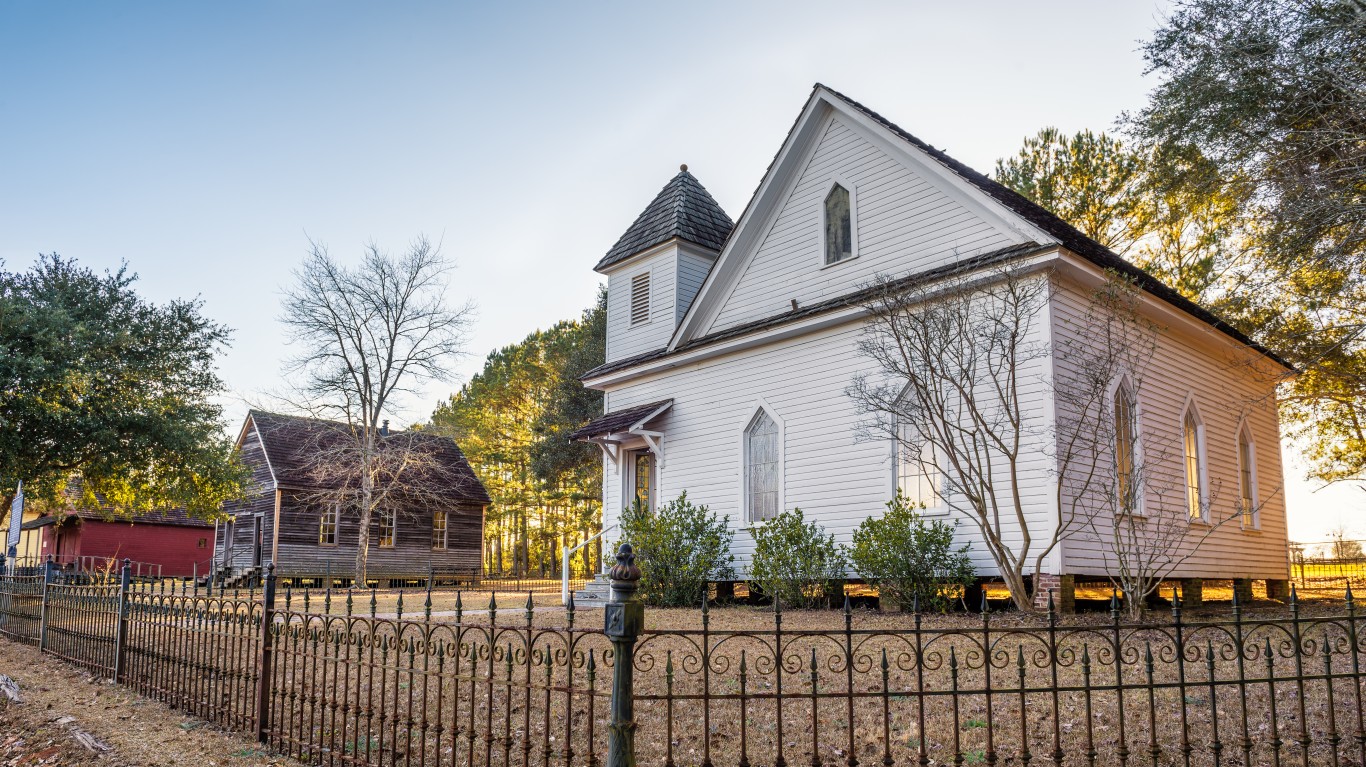
16. Dothan, AL
> Median annual wage: $31,550
> April 2021 unemployment rate: 3.3%
> Poverty rate: 18.6%
The median annual wage in the Dothan metro area in southeastern Alabama is $31,550, lower than all but 15 other major population centers in America. The area’s poverty rate of 18.6% is well above the nation’s 12.3% poverty rate.
Workers with college degrees tend to earn higher wages than those without. Like nearly every other metro area on this list, Dothan has a relatively low bachelor’s degree attainment rate — just 20.1% of Dothan residents 25 and older have earned at least a college degree. The U.S. bachelor’s degree attainment rate is 33.1%.
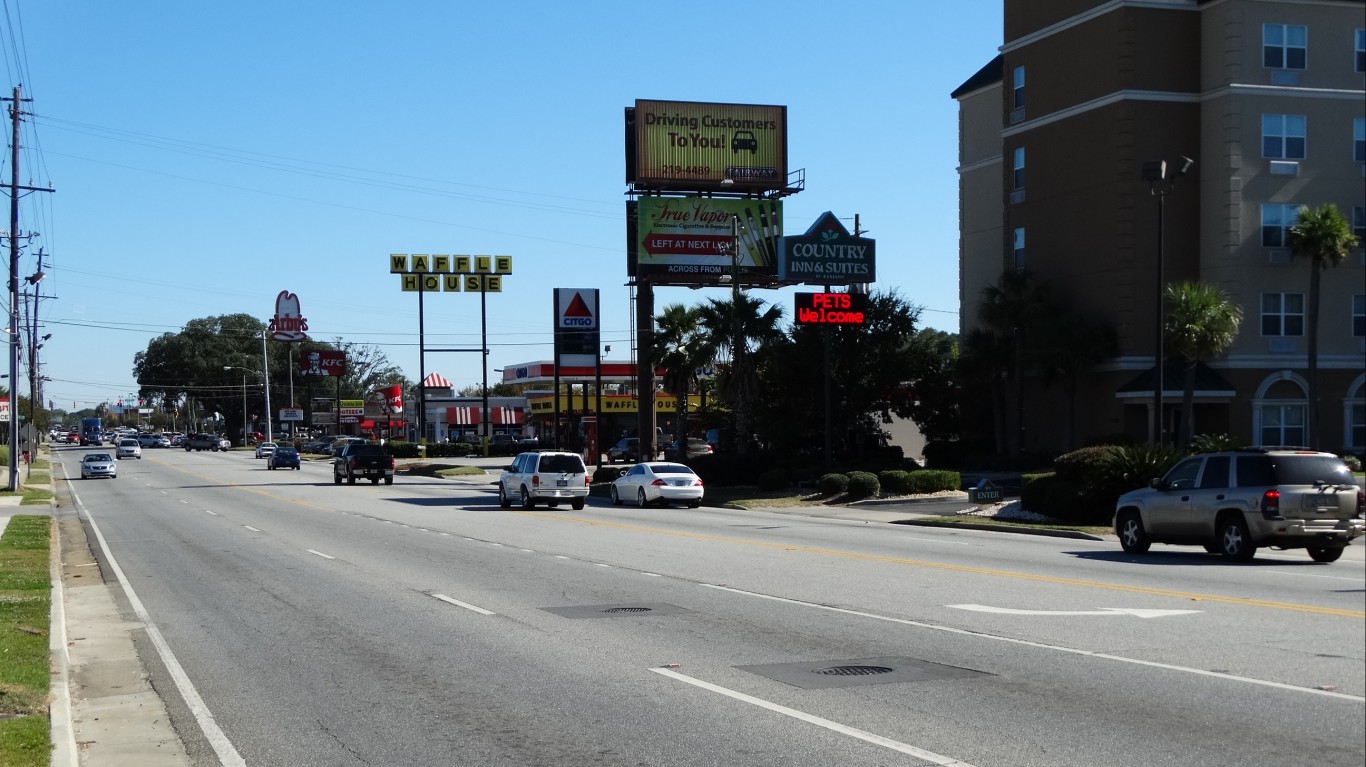
15. Valdosta, GA
> Median annual wage: $31,540
> April 2021 unemployment rate: 4.3%
> Poverty rate: 20.9%
The median annual wage in the Valdosta metro area of southern Georgia is the 15th lowest of any U.S. metro area, at $31,540. Valdosta is one of just 24 metro areas in America in which more than one out of every five people live below the poverty line.
Like the majority of metro areas on this list, the largest job sector in Valdosta is office and administrative support occupations, accounting for 13.3% of all area jobs. The sector includes jobs like bill collectors, assistants, secretaries, customer service representatives, and more. In the Valdosta area, most of these workers earn less than $29,500 per year.
[in-text-ad]
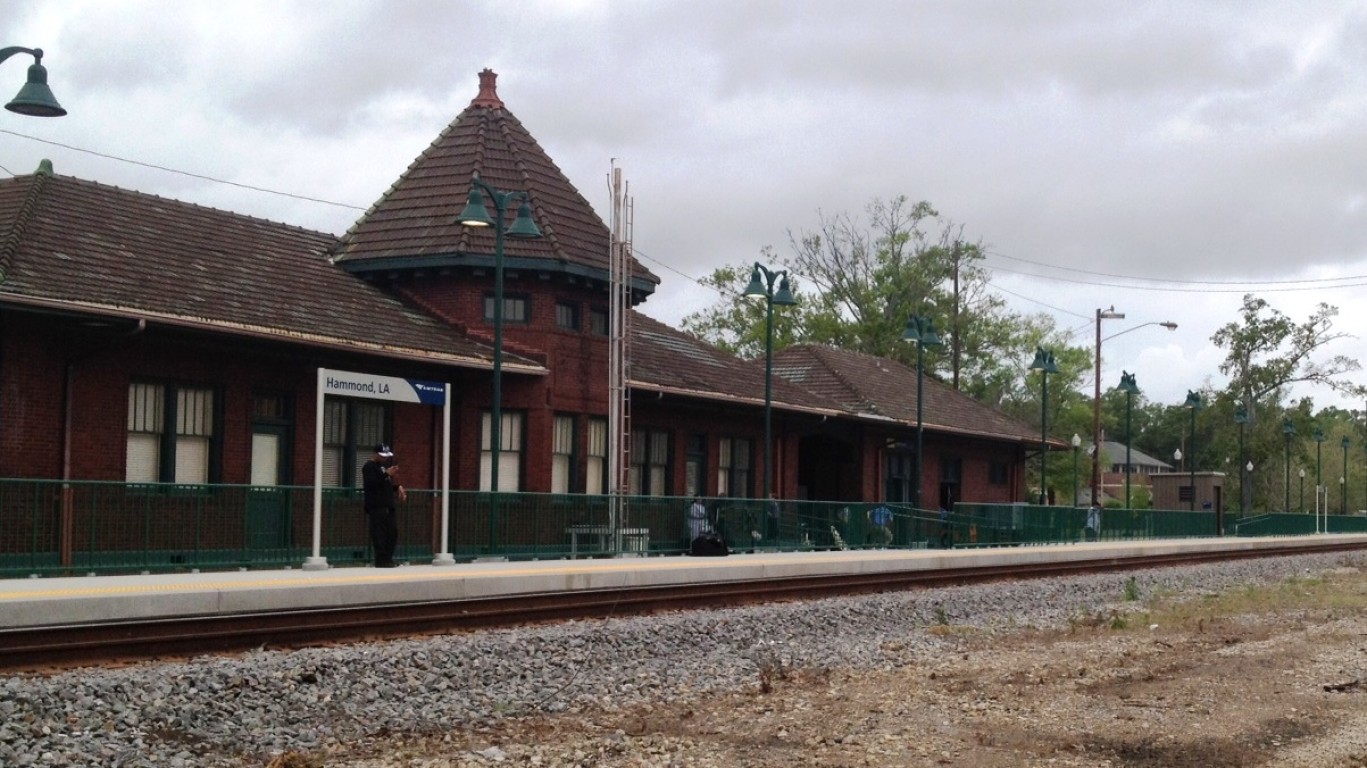
13. Hammond, LA (tied)
> Median annual wage: $31,490
> April 2021 unemployment rate: 8.2%
> Poverty rate: 22.9%
The Hammond metro area is tied with another Louisiana metro area, Monroe, for the 13th lowest median annual wage in the country. The typical worker earns less than $31,500 in a year, whereas the typical U.S. worker earns just under $42,000 per year.
Beyond low wages, the Hammond metro area job market is struggling. The area’s unemployment rate of 8.2% as of April 2021 was well above the 6.1% national unemployment rate. Hammond also has the seventh highest poverty rate in the country, at 22.9%. The U.S. poverty rate is 12.3%.

13. Monroe, LA (tied)
> Median annual wage: $31,490
> April 2021 unemployment rate: 6.4%
> Poverty rate: 26.0%
The Monroe metro area in northern Louisiana has a median annual wage of just $31,490, lower than all but a dozen other major population centers in the U.S. Wages in the area are growing slowly, as well, increasing by just 11.1% from 2015 to 2020 — one of the lowest wage growths out of nearly 400 U.S. metro areas. The Monroe metro area also shed nearly 5% of area jobs in that five-year stretch.
A very high share of households in Monroe live on very little income — 13.8% earn less than $10,000. This is by far the highest share in the country, and well more than double the national share of households living at this income level of 5.8%. Monroe also has the nation’s second-highest poverty rate, at 26.0%.

12. Homosassa Springs, FL
> Median annual wage: $31,390
> April 2021 unemployment rate: 7.1%
> Poverty rate: 15.7%
Homosassa Springs is located about 60 miles north of Tampa, along Florida’s western coast. The area’s median annual wage increased slowly in recent years, growing by 13.8% from 2015 to 2020 to $31,390. The area has also lost more than 2% of its workers during that time.
More than 13% of all workers in the Homosassa Springs area work in the sales sector, making it the area’s largest sector by employment. The sector includes jobs like cashier and retail sales worker. The median annual income for area workers in the sales is just $24,500.
[in-text-ad-2]
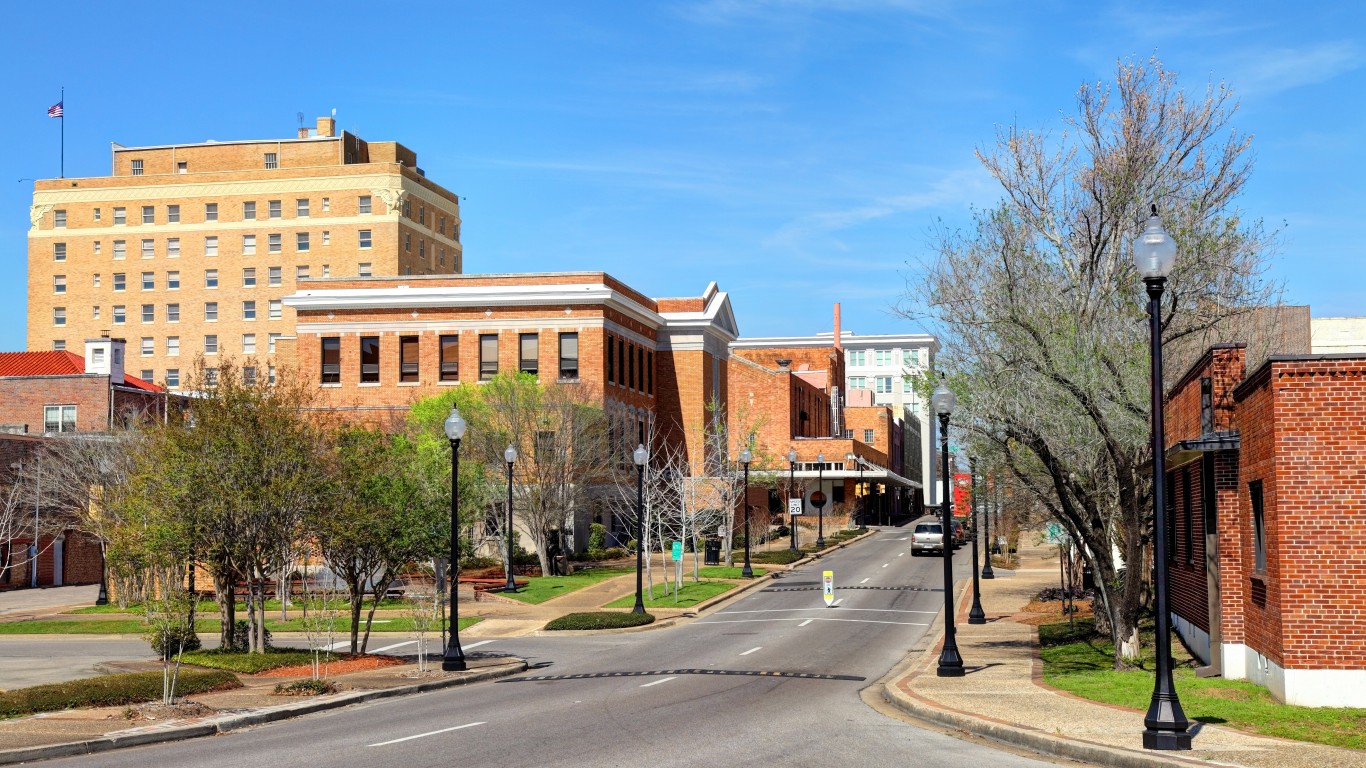
11. Hattiesburg, MS
> Median annual wage: $31,370
> April 2021 unemployment rate: 5.6%
> Poverty rate: 22.5%
Hattiesburg, Mississippi, workers have a median annual wage of $31,370. Only 10 other metro areas in the U.S. out of nearly 400 have a lower median wage. Low wages typically translate to a high poverty rate, and Hattiesburg’s poverty rate of 22.5% ranks 11th highest in the country.
More than 15% of Hattiesburg area workers are employed in office and administrative support occupations like customer service representatives, office clerks, receptionists and more. The median annual income of these jobs in the area is $28,610.

10. Daphne-Fairhope-Foley, AL
> Median annual wage: $31,250
> April 2021 unemployment rate: 2.9%
> Poverty rate: 10.1%
The Daphne metro area in southwestern Alabama has one of the fastest-growing job markets in the country. The number of area workers increased by 10% from 2015 to 2020, about 11 times faster than employment growth in the U.S. overall. The area reported an unemployment rate of 2.9% in April 2021, less than half of the U.S. rate.
Yet the typical area jobs do not pay well. The area’s median annual wage of $31,250 is $10,700 lower than the U.S. median. The two largest job sectors in the Daphne metro area are sales and food preparation and serving occupations, which pay median annual wages of $28,480 and $20,260, respectively, to workers in the area.
[in-text-ad]

9. Sebring, FL
> Median annual wage: $30,780
> April 2021 unemployment rate: 6.6%
> Poverty rate: 14.4%
The Sebring metro area is about 75 miles south of Orlando in central Florida. It is one of just nine metro areas in the country in which most workers earn less than $31,000 annually. More than 3% of the workers in the area work as farmworkers and laborers or in farming, fishing and forestry occupations — these two highly concentrated industries typically pay workers less than $25,000 per year.
Earnings tend to increase with education level — workers with a high school diploma tend to earn more than those without, and workers with a bachelor’s degree earn even higher wages. Lower-income areas therefore tend to have lower educational attainment rates, and Sebring is no exception. Just 85.1% of Sebring adults 25 and older hold at least a high school diploma, compared to 88.6% of all Americans that age. The area’s bachelor’s degree attainment rate of 16.7% is also low, just over half of the U.S. rate of 33.1%.

8. El Paso, TX
> Median annual wage: $30,590
> April 2021 unemployment rate: 7.7%
> Poverty rate: 18.7%
The El Paso metro area makes up the far western point of the Texas panhandle. It is one of four Texas Metro areas to have among the 10 lowest median annual wages in the country. Most workers in the area earn less than $30,600.
As is the case with many areas on this list, people in El Paso are much more likely to struggle financially than the typical American. The area’s 18.7% poverty rate is one of the highest in the nation, and well above the 12.3% national poverty rate.

7. Cleveland, TN
> Median annual wage: $30,330
> April 2021 unemployment rate: 5.1%
> Poverty rate: 15.2%
The Cleveland metro area is located just across from Tennessee’s southern border with Georgia. The area’s median annual wage of $30,300 is the seventh lowest median in the nation, equivalent to an hourly wage of $14.58.This is the seventh lowest median in the nation, equivalent to an hourly wage of $14.58.
The number of workers in the Cleveland, Tennessee, metro area increased from under 45,000 workers in 2015 to over 47,000 in 2020, a 4.5% increase. Nationwide, the number of workers increased by less than 1%. Even as the number of workers increased rapidly, wages did not. The area’s median annual wage increased by 11.6% from 2015 to 2020, well behind the nationwide 15.9% increase.
[in-text-ad-2]

6. Myrtle Beach-Conway-North Myrtle Beach, SC-NC
> Median annual wage: $30,120
> April 2021 unemployment rate: 5.4%
> Poverty rate: 11.8%
Over the past five years, both the number of jobs and the amount those jobs pay have increased in the Myrtle Beach metro area along the North Carolina-South Carolina border. The total area employment increased by more than 5% from 2015 to 2020, well above the 0.9% increase nationwide. The median annual wage increased by 18.7%, also well above the U.S. increase. Still, the area’s median annual wage of $30,120 is lower than all but five other U.S. metro areas.
The Myrtle Beach area is a popular vacation spot, attracting tourists from across the country to its beaches. About one out of every six jobs in the area falls under the food preparation and serving sector. These jobs typically do not pay well, with a median annual wage of just over $21,000 — roughly half of the overall U.S. median annual wage for all occupations.

5. Laredo, TX
> Median annual wage: $29,790
> April 2021 unemployment rate: 7.4%
> Poverty rate: 20.5%
The Laredo metro area in southern Texas is one of just five U.S. metro areas in which most workers earn less than $30,000 per year. However, the area has shown improvement — its median annual wage increased by 19.3% from 2015 to 2020, well above the 15.9% increase nationwide for all occupations. The number of workers in the area has also grown rapidly, up 3.0% in the last five years — more than triple the nationwide rate of growth.
A lack of education may be contributing to relatively low earnings in Laredo. Just 66.1% of area adults 25 and older have a high school diploma — the lowest share among all metro areas and well below the 88.6% nationwide share. Workers with high school diplomas tend to earn much more than those without.
[in-text-ad]

4. Hot Springs, AR
> Median annual wage: $29,560
> April 2021 unemployment rate: 5.9%
> Poverty rate: 17.4%
The Hot Springs area of central Arkansas has a median annual wage of $29,560, lower than all but three other U.S. metro areas. The largest job sector is sales and related occupations, which includes jobs like cashiers, retail sales workers, and more. The sector, which accounts for 13.1% of the area’s total employment, has a median annual wage of $25,180 in the Hot Springs area.
As is the case with many other areas with low wages, the number of people working in the Hot Springs area is in decline. The area’s total employment fell by 1.4% from 2015 to 2020, even as the number of total workers in the U.S. grew during that time.

3. Gadsden, AL
> Median annual wage: $29,520
> April 2021 unemployment rate: 4.1%
> Poverty rate: 19.7%
The Gadsden, Alabama, metro area has some of the lowest paying jobs in the country. The area’s median annual wage is just $29,520, more than $12,000 less than the U.S. median. The area is facing a severe shortage of jobs — employment dropped by a staggering 10.6% from 2015 to 2020, compared to nationwide employment expanding by nearly 1% during that time.
Gadsden has a relatively low unemployment rate, at 4.1%. Holding a job is not enough to keep one out of poverty, however, and nearly one in five area residents lives below the poverty line. Gadsden’s largest employment sector is production, which has occupations like manufacturing, employing 13.7% of all workers. Production workers in the area have median annual wages of just over $24,000.

2. McAllen-Edinburg-Mission, TX
> Median annual wage: $27,880
> April 2021 unemployment rate: 11.4%
> Poverty rate: 27.3%
The McAllen metro area in southern Texas is one of just two U.S. population centers in which most workers earn less than $28,000. The area’s economy is struggling, based on a number of key indicators. The area’s 27.3% poverty rate is by far the highest in the nation and more than double the U.S. poverty rate. McAllen also had the fifth highest unemployment rate as of April 2021, at 11.4%.
Nearly a third of workers in the McAllen area work either in a health care support occupation or as a home health and personal care aide. These health care job sectors pay relatively low wages — both sectors have an annual median wage of less than $23,000.
[in-text-ad-2]
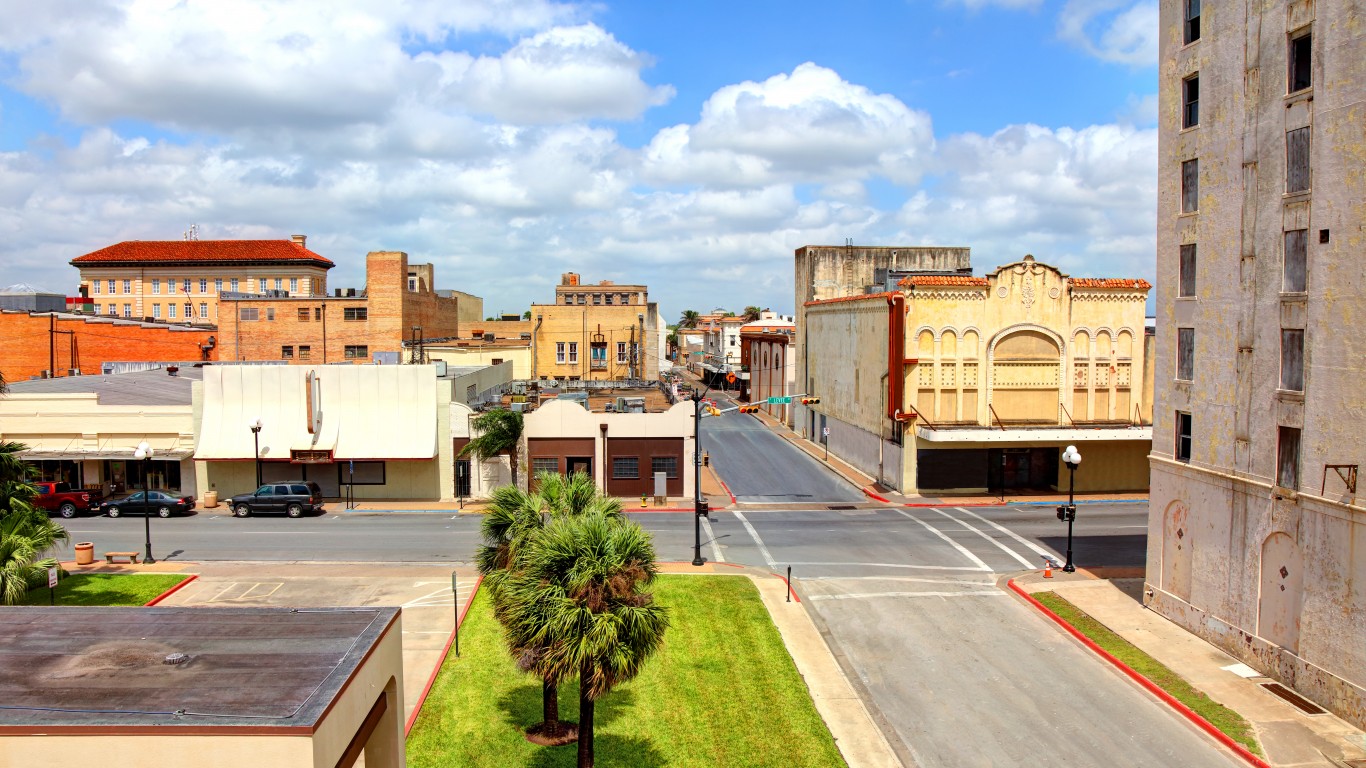
1. Brownsville-Harlingen, TX
> Median annual wage: $25,680
> April 2021 unemployment rate: 9.8%
> Poverty rate: 25.6%
The Brownsville-Harlingen metro area at the very southern tip of Texas is the U.S. metro area with by far the lowest paying jobs. The median annual wage of the area is $25,680 — more than $2,000 lower than any other city and well below the overall U.S. median of nearly $42,000.
Of the 25 metro areas with the lowest paying jobs, the Brownsville area reported the slowest median wage growth from 2015 to 2020, at 10.2%. Nationwide, the median annual wage grew by 15.9% during that time.
Methodology
To determine the cities with the lowest paying jobs, 24/7 Wall St. reviewed data on median wage for 389 metropolitan statistical areas from the U.S. Bureau of Labor Statistics Occupational Employment and Wage Statistics program. Metropolitan areas were ranked based on the median annual wage for all occupations as of May 2020. Data on employment and location quotient, used to determine the relative concentration of a job within a metro area, also came from the BLS OEWS. Supplemental data on regional price parity, a measure of cost of living, came from the Bureau of Economic Analysis and is for 2019. Data on poverty rate came from the U.S. Census Bureau’s 2019 American Community Survey and are one-year estimates.
Take Charge of Your Retirement: Find the Right Financial Advisor For You in Minutes (Sponsor)
Retirement planning doesn’t have to feel overwhelming. The key is finding professional guidance—and we’ve made it easier than ever for you to connect with the right financial advisor for your unique needs.
Here’s how it works:
1️ Answer a Few Simple Questions
Tell us a bit about your goals and preferences—it only takes a few minutes!
2️ Get Your Top Advisor Matches
This tool matches you with qualified advisors who specialize in helping people like you achieve financial success.
3️ Choose Your Best Fit
Review their profiles, schedule an introductory meeting, and select the advisor who feels right for you.
Why wait? Start building the retirement you’ve always dreamed of. Click here to get started today!
Thank you for reading! Have some feedback for us?
Contact the 24/7 Wall St. editorial team.
 24/7 Wall St.
24/7 Wall St.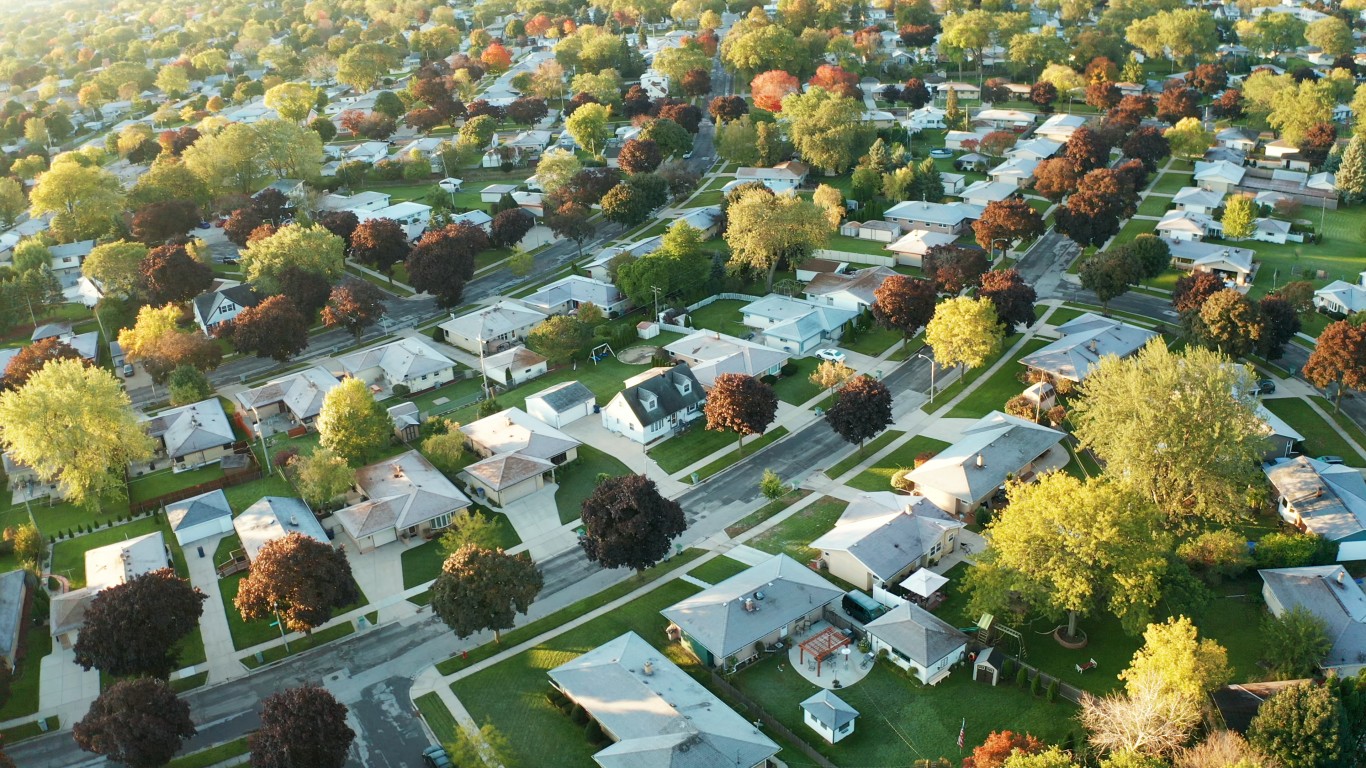 24/7 Wall St.
24/7 Wall St. 24/7 Wall St.
24/7 Wall St. 24/7 Wall St.
24/7 Wall St. 24/7 Wall St.
24/7 Wall St.

